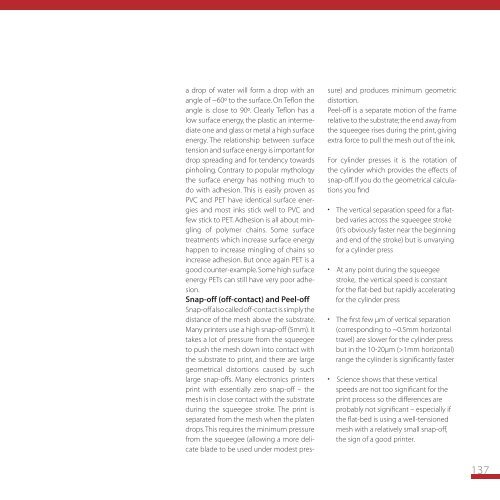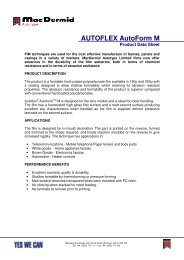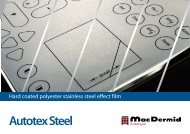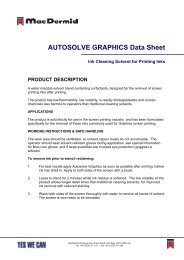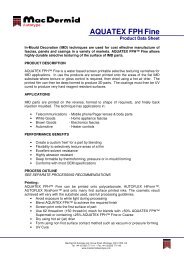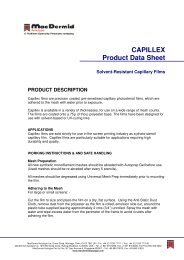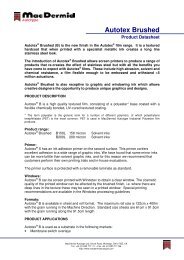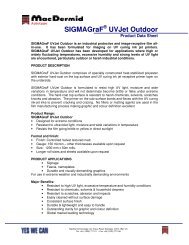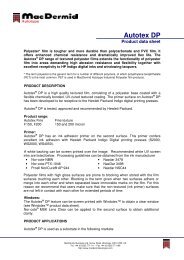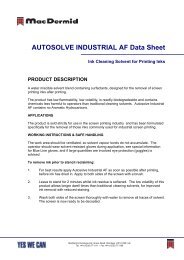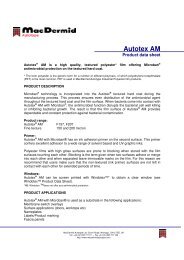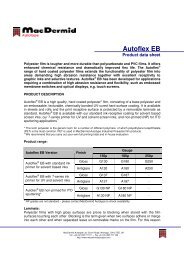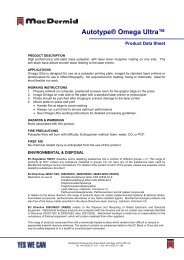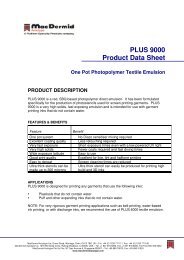Screen E-Book (.PDF) - MacDermid Autotype
Screen E-Book (.PDF) - MacDermid Autotype
Screen E-Book (.PDF) - MacDermid Autotype
- No tags were found...
You also want an ePaper? Increase the reach of your titles
YUMPU automatically turns print PDFs into web optimized ePapers that Google loves.
a drop of water will form a drop with anangle of ~60º to the surface. On Teflon theangle is close to 90º. Clearly Teflon has alow surface energy, the plastic an intermediateone and glass or metal a high surfaceenergy. The relationship between surfacetension and surface energy is important fordrop spreading and for tendency towardspinholing. Contrary to popular mythologythe surface energy has nothing much todo with adhesion. This is easily proven asPVC and PET have identical surface energiesand most inks stick well to PVC andfew stick to PET. Adhesion is all about minglingof polymer chains. Some surfacetreatments which increase surface energyhappen to increase mingling of chains soincrease adhesion. But once again PET is agood counter-example. Some high surfaceenergy PETs can still have very poor adhesion.Snap-off (off-contact) and Peel-offSnap-off also called off-contact is simply thedistance of the mesh above the substrate.Many printers use a high snap-off (5mm). Ittakes a lot of pressure from the squeegeeto push the mesh down into contact withthe substrate to print, and there are largegeometrical distortions caused by suchlarge snap-offs. Many electronics printersprint with essentially zero snap-off – themesh is in close contact with the substrateduring the squeegee stroke. The print isseparated from the mesh when the platendrops. This requires the minimum pressurefrom the squeegee (allowing a more delicateblade to be used under modest pressure)and produces minimum geometricdistortion.Peel-off is a separate motion of the framerelative to the substrate; the end away fromthe squeegee rises during the print, givingextra force to pull the mesh out of the ink.For cylinder presses it is the rotation ofthe cylinder which provides the effects ofsnap-off. If you do the geometrical calculationsyou find• The vertical separation speed for a flatbedvaries across the squeegee stroke(it’s obviously faster near the beginningand end of the stroke) but is unvaryingfor a cylinder press• At any point during the squeegeestroke, the vertical speed is constantfor the flat-bed but rapidly acceleratingfor the cylinder press• The first few µm of vertical separation(corresponding to ~0.5mm horizontaltravel) are slower for the cylinder pressbut in the 10-20µm (>1mm horizontal)range the cylinder is significantly faster• Science shows that these verticalspeeds are not too significant for theprint process so the differences areprobably not significant – especially ifthe flat-bed is using a well-tensionedmesh with a relatively small snap-off,the sign of a good printer.137


